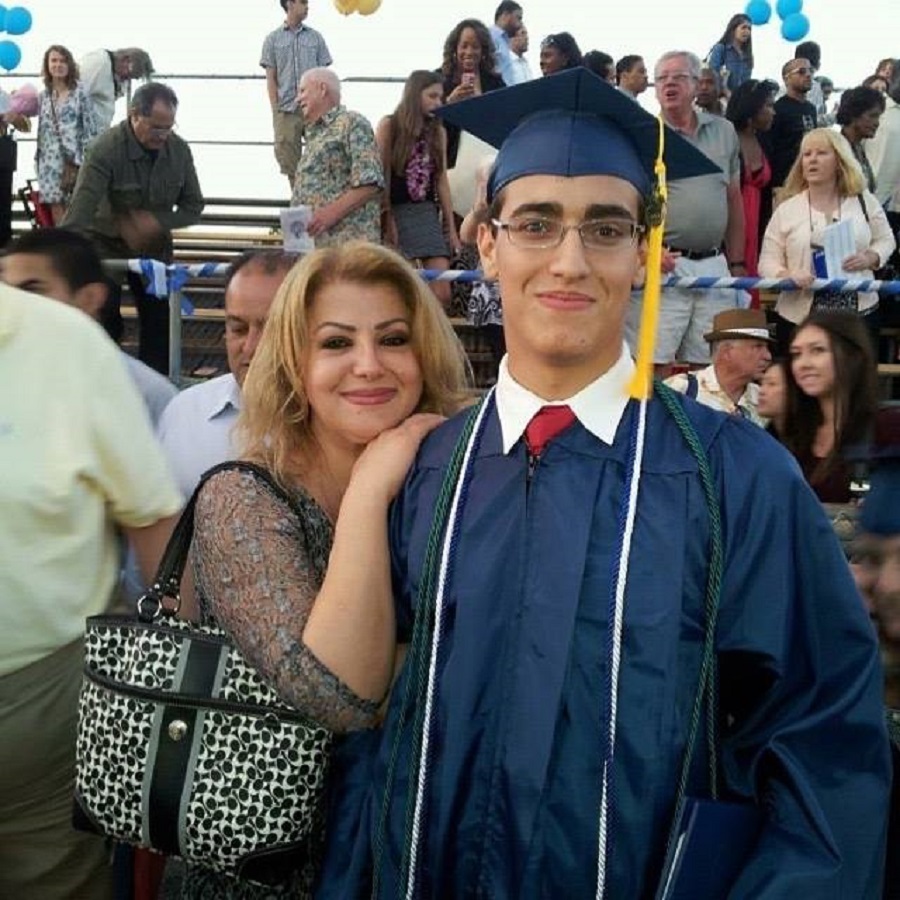Depending on who’s telling the story, Feras Morad was either a disoriented college student in desperate need of medical attention when a panicked Long Beach police officer killed him, or he was an unpredictable and aggressive threat to public safety who’d violently resisted arrest before the officer made a split-second decision to shoot in self-defense.
For the past two weeks, jurors at a federal courthouse in downtown Los Angeles have heard these dueling descriptions in an excessive force and wrongful death lawsuit brought by Morad’s family against the police officer and the city of Long Beach.
Some facts in the case are undisputed: Morad either jumped or fell out of second-story window near Long Beach’s Traffic Circle neighborhood on the evening of May 27, 2015, where he’d been hanging out with his college debate team.
A 911 call went out to paramedics telling them Morad was bloodied, shirtless and needing help. Police were sent to the scene, too. A dispatcher told them that a bloodied man appeared to be intoxicated and was acting violently after falling out of the window, according to a recording of the dispatch played at trial.
Morad never got treated for his injuries from the fall. The first police officer to arrive at the scene struggled with Morad and then shot him to death, according to court documents.
But what led to the decision to shoot is in dispute, and it’s now up to a jury to determine whether veteran Officer Matthew Hernandez made a reasonable choice to fire on 20-year-old Morad, who was attending Cal State Long Beach on a scholarship.

Before eight jurors began deliberating Wednesday afternoon, the attorneys got a final chance to highlight the evidence they thought best supported their arguments.
Dan Stormer, representing Morad’s family, blamed Hernandez for escalating the situation when he tried to arrest Morad, who was reportedly stumbling around the area erratically, according to court documents.
“I think we can all agree on one thing, that if Officer Hernandez had not shown up on the evening of May 27, 2015, Feras Morad would be alive today,” Stormer said. “There was no need for this shooting.”
Stormer highlighted the testimony of three firefighters who watched the events unfold. They all said that Morad didn’t appear to be violent or threatening, according to Stormer.
The fire captain at the scene even told Hernandez not to shoot when he saw the officer had drawn his gun, according to court documents.
“There’s not a single person that can say Mr. Morad hit the officer, punched the officer,” he said. “Even the officer doesn’t say that.”
Stormer painted Hernandez as the aggressor. As the officer tried to take Morad into custody before the fatal shooting, he yanked him to the ground, tried to use a Taser on him, hit him in the leg with a flashlight, grappled with him and at one point tried to shoot Morad but was foiled because his safety was still on.
But Hernandez’ attorney, Kyle Bevan, presented a much different interpretation. He emphasized the officer’s testimony that Morad ignored orders and wrestled with the officer.
“Someone who is nonviolent and nonthreatening doesn’t result in a police officer essentially losing a fistfight and covered in blood,” said Bevan, clarifying that it was Morad’s blood.
Hernandez testified that Morad did try to attack him. He said Morad windmilled his fists as he walked, swung an elbow at his head and at one point said something like “I’m coming to get you,” according to court documents.
But after about three minutes of struggling, Morad sat down on the pavement, according to Hernandez’ account. Hernandez said he then called for backup and pulled out his weapon again to point at Morad, trying to deter any more confrontation.
When Morad got up again and came toward him with fist clenched, Hernandez said he fired, according to court documents.
“Although it’s tragic, Officer Hernandez was faced with a tough decision and did what he needed to do,” Bevan said.
Attorneys for both sides pointed out that witness accounts of those last few moments vary widely. In sharp contrast to Hernandez, one of the firefighters, Robert Grego, said Morad was down on one knee, not advancing toward Hernandez, when the officer shot him.
The attorney representing Long Beach, Howard Russell, urged jurors to look at the situation through the lens of a police officer who’d already tried and failed to get Morad to surrender.
“The officer’s got to choose, do I give this guy a last chance after so many chances, or do I save my life?” Russell said.
Stormer questioned why Hernandez struggled with Morad and ultimately drew his weapon instead of accepting help from the nearby firefighters.
“They were 10 to 20 feet away, saying let us take him down,” Stormer said.
Bevan, however, appeared to lay some blame at the firefighters’ feet, saying they’d arrived at the scene first.
He said that—unlike police officers who confront suspects—firefighters are paid to “exchange chili recipes,” polish fire engines and “occasionally help someone.”
“In this case, they didn’t,” Bevan said. “They sauntered over to someone who’d fallen out of a second-story with no sense of urgency at all.”
Last year, the Los Angeles District Attorney’s office declined to press criminal charges against Hernandez, instead concluding he was acting on “an honest belief in the need for self-defense and defense of others when he used deadly force against Feras Morad.”
If jurors decide differently in this civil case, they will then have the task of determining what damages Long Beach and Hernandez would be liable for.

